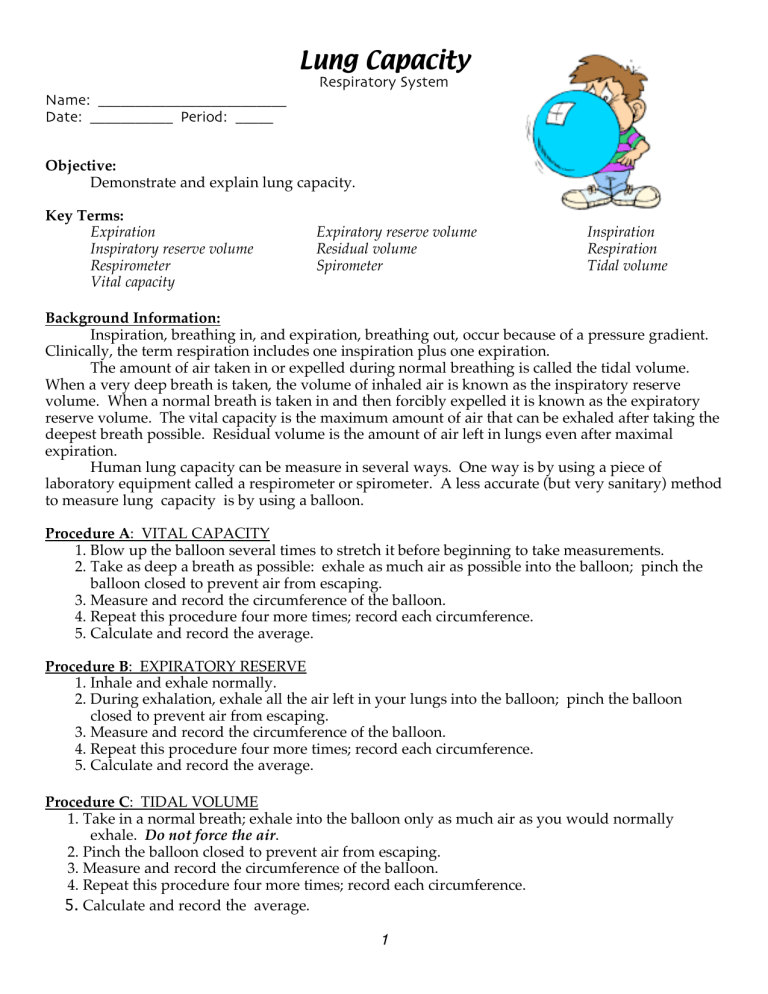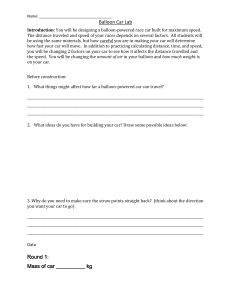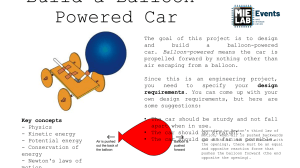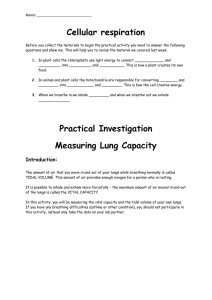
Lung Capacity Respiratory System Name: _________________________ Date: ___________ Period: _____ Objective: Demonstrate and explain lung capacity. Key Terms: Expiration Inspiratory reserve volume Respirometer Vital capacity Expiratory reserve volume Residual volume Spirometer Inspiration Respiration Tidal volume Background Information: Inspiration, breathing in, and expiration, breathing out, occur because of a pressure gradient. Clinically, the term respiration includes one inspiration plus one expiration. The amount of air taken in or expelled during normal breathing is called the tidal volume. When a very deep breath is taken, the volume of inhaled air is known as the inspiratory reserve volume. When a normal breath is taken in and then forcibly expelled it is known as the expiratory reserve volume. The vital capacity is the maximum amount of air that can be exhaled after taking the deepest breath possible. Residual volume is the amount of air left in lungs even after maximal expiration. Human lung capacity can be measure in several ways. One way is by using a piece of laboratory equipment called a respirometer or spirometer. A less accurate (but very sanitary) method to measure lung capacity is by using a balloon. Procedure A: VITAL CAPACITY 1. Blow up the balloon several times to stretch it before beginning to take measurements. 2. Take as deep a breath as possible: exhale as much air as possible into the balloon; pinch the balloon closed to prevent air from escaping. 3. Measure and record the circumference of the balloon. 4. Repeat this procedure four more times; record each circumference. 5. Calculate and record the average. Procedure B: EXPIRATORY RESERVE 1. Inhale and exhale normally. 2. During exhalation, exhale all the air left in your lungs into the balloon; pinch the balloon closed to prevent air from escaping. 3. Measure and record the circumference of the balloon. 4. Repeat this procedure four more times; record each circumference. 5. Calculate and record the average. Procedure C: TIDAL VOLUME 1. Take in a normal breath; exhale into the balloon only as much air as you would normally exhale. Do not force the air. 2. Pinch the balloon closed to prevent air from escaping. 3. Measure and record the circumference of the balloon. 4. Repeat this procedure four more times; record each circumference. 5. Calculate and record the average. 1 Name: _________________________Date: ___________ Period: _____ Procedure D: CONVERSION OF AVERAGE CIRCUMFERENCE TO VOLUME 1. Lung volume is expressed in cubic centimeters (cm3). 1, 000 cm3 = 1,000 mL (1L) 2. Convert the circumference into diameter ( diameter = circumference ÷ π ) from Procedure A-C. 3. To convert from balloon diameter to volume use the graph below. 4. Record the volumes in the data section. Circumference Procedure A Vital Capacity Procedure B Expiratory Reserve Procedure C Tidal Volume Trial 1 Trial 2 Trial 3 Trial 4 Trial 5 Average DATA: Procedure A-C DATA: Procedure D Conversion of Circumference Diameter (cm) Volume (cm3) Procedure A Vital Capacity Procedure B Expiratory Reserve 2 Procedure C Tidal Volume ANALYSIS 1. Use the key terms from the introduction to label the missing portions of the diagram below. MALE FEMALE Vital Capacity 5,000 mL 4,000 mL Expiratory Reserve 1,200 mL 1,000 mL 525 mL 475 mL Tidal Volume 2. Compare your average with the following averages taken by a spirometer. 3. Calculate the difference between your data and the averages (use + or - to indicate if your data was Average Your Data Difference (+ or -) Vital Capacity mL mL mL Expiratory Reserve mL mL mL Tidal Volume mL mL mL above or below the average). 4. What factors could affect your results being above or below the spirometer averages (besides experimental error)? 3




